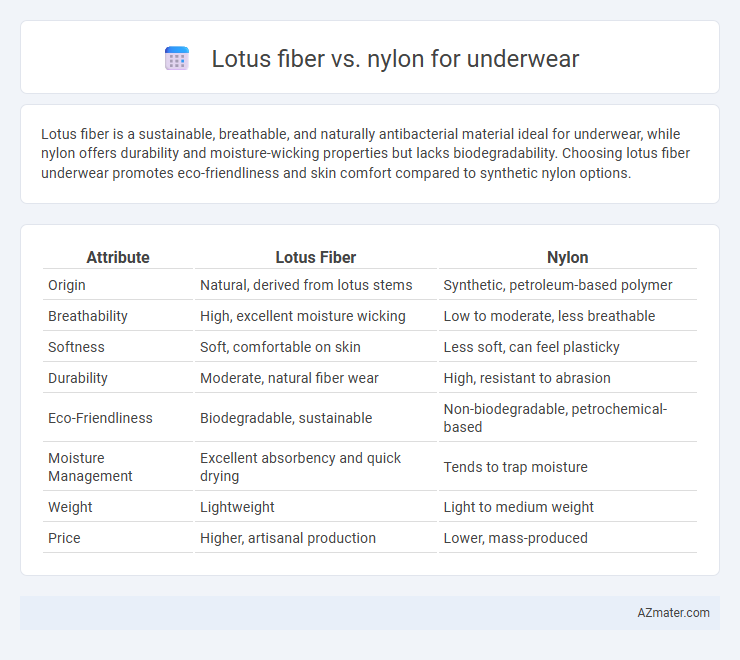Lotus fiber is a sustainable, breathable, and naturally antibacterial material ideal for underwear, while nylon offers durability and moisture-wicking properties but lacks biodegradability. Choosing lotus fiber underwear promotes eco-friendliness and skin comfort compared to synthetic nylon options.
Table of Comparison
| Attribute | Lotus Fiber | Nylon |
|---|---|---|
| Origin | Natural, derived from lotus stems | Synthetic, petroleum-based polymer |
| Breathability | High, excellent moisture wicking | Low to moderate, less breathable |
| Softness | Soft, comfortable on skin | Less soft, can feel plasticky |
| Durability | Moderate, natural fiber wear | High, resistant to abrasion |
| Eco-Friendliness | Biodegradable, sustainable | Non-biodegradable, petrochemical-based |
| Moisture Management | Excellent absorbency and quick drying | Tends to trap moisture |
| Weight | Lightweight | Light to medium weight |
| Price | Higher, artisanal production | Lower, mass-produced |
Introduction to Lotus Fiber and Nylon
Lotus fiber, derived from the stems of lotus plants, is a rare, eco-friendly natural textile known for its breathability, moisture-wicking properties, and silky texture, making it ideal for sustainable underwear. Nylon, a synthetic polymer extensively used in underwear, offers exceptional durability, elasticity, and moisture management but is less breathable and less environmentally friendly compared to lotus fiber. Choosing between lotus fiber and nylon depends on prioritizing natural comfort and sustainability versus durability and stretch.
Origin and Composition of Lotus Fiber
Lotus fiber originates from the stem of the lotus plant, primarily found in Southeast Asia, and is a natural, sustainable material known for its environmental benefits and breathability. Composed of cellulose, lotus fiber is biodegradable and softer than nylon, which is a synthetic polymer derived from petrochemicals known for its strength and elasticity. The natural origin and hypoallergenic properties of lotus fiber offer a sustainable alternative to nylon in underwear, providing comfort and eco-friendliness without compromising durability.
Properties and Structure of Nylon
Nylon is a synthetic polymer known for its strength, elasticity, and resistance to abrasion, making it highly durable and shape-retentive in underwear applications. Its smooth, non-absorbent fiber structure allows for quick moisture-wicking and fast drying, enhancing comfort during physical activities. Unlike Lotus fiber, which is biodegradable and naturally breathable, Nylon's chemical composition provides superior longevity and resilience but may retain odors and lacks the natural antibacterial properties.
Breathability and Comfort Comparison
Lotus fiber offers superior breathability compared to nylon due to its natural micro-gaps that allow air to circulate, reducing moisture and heat buildup. The fabric's lightweight and soft texture enhances comfort, making it ideal for sensitive skin and prolonged wear. Nylon, while durable and moisture-wicking, tends to trap heat and feels less breathable, which can cause discomfort during extended use.
Moisture-Wicking and Quick-Dry Abilities
Lotus fiber underwear offers superior moisture-wicking properties due to its natural porous structure, which efficiently draws sweat away from the skin, enhancing comfort during prolonged wear. In contrast, nylon, a synthetic fabric, also provides effective moisture management but tends to trap heat, potentially causing discomfort in hot conditions. Lotus fiber's quick-dry ability outperforms nylon by allowing faster evaporation of moisture, making it an ideal choice for breathable, dry, and comfortable underwear.
Durability and Longevity in Underwear
Lotus fiber underwear offers superior durability due to its natural strength and resistance to wear and tear, making it ideal for long-term use. Nylon, while also durable, tends to degrade faster with frequent washing and exposure to heat, potentially reducing the lifespan of underwear. Lotus fiber's moisture-wicking and antimicrobial properties further enhance its longevity by preventing fabric breakdown and maintaining freshness over time.
Eco-Friendliness and Sustainability Factors
Lotus fiber, derived from lotus plant stems, offers exceptional eco-friendliness due to its biodegradable nature and low water consumption during production compared to nylon, which is a synthetic polymer derived from fossil fuels with significant environmental impact. The manufacturing of lotus fiber involves minimal chemicals and renewable plant resources, enhancing sustainability by reducing carbon emissions and pollution typical of nylon production. Choosing lotus fiber underwear supports sustainable fashion practices by promoting biodegradable materials and reducing reliance on non-renewable, petroleum-based fibers like nylon.
Skin Sensitivity and Allergen Considerations
Lotus fiber is naturally hypoallergenic and breathable, making it ideal for sensitive skin and reducing the risk of irritation or allergic reactions compared to nylon. Nylon, a synthetic fabric, can trap moisture and heat, often leading to skin discomfort and increased susceptibility to allergies or rashes. Choosing lotus fiber underwear supports better skin health by providing antimicrobial properties and moisture-wicking benefits essential for sensitive skin.
Cost Evaluation: Lotus Fiber vs Nylon
Lotus fiber underwear typically incurs higher production costs due to its labor-intensive extraction process and limited raw material availability compared to nylon, which benefits from large-scale industrial manufacturing and cost-efficient synthetic production. The natural origin of lotus fiber provides eco-friendly and biodegradable advantages but results in a significantly higher price point, making it more expensive for consumers than nylon underwear. Nylon remains the more cost-effective option for mass market underwear due to its durability, lower material costs, and widespread accessibility.
Final Thoughts: Choosing the Best Underwear Material
Lotus fiber offers exceptional breathability, natural antibacterial properties, and eco-friendly benefits, making it ideal for sensitive skin and sustainable fashion. Nylon, while durable and stretchy, tends to trap moisture and heat, potentially causing discomfort during extended wear. Prioritizing breathability and environmental impact, Lotus fiber is the superior choice for comfortable, breathable, and sustainable underwear materials.

Infographic: Lotus fiber vs Nylon for Underwear
 azmater.com
azmater.com